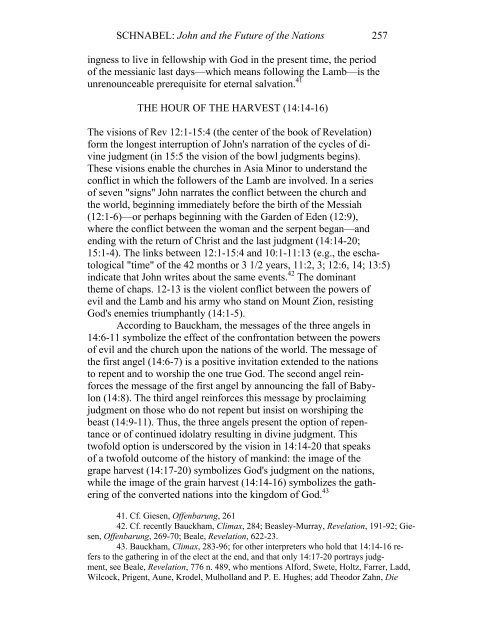John and the Future of the Nations - Institute for Biblical Research
John and the Future of the Nations - Institute for Biblical Research
John and the Future of the Nations - Institute for Biblical Research
You also want an ePaper? Increase the reach of your titles
YUMPU automatically turns print PDFs into web optimized ePapers that Google loves.
SCHNABEL: <strong>John</strong> <strong>and</strong> <strong>the</strong> <strong>Future</strong> <strong>of</strong> <strong>the</strong> <strong>Nations</strong> 257<br />
ingness to live in fellowship with God in <strong>the</strong> present time, <strong>the</strong> period<br />
<strong>of</strong> <strong>the</strong> messianic last days—which means following <strong>the</strong> Lamb—is <strong>the</strong><br />
unrenounceable prerequisite <strong>for</strong> eternal salvation. 41<br />
THE HOUR OF THE HARVEST (14:14-16)<br />
The visions <strong>of</strong> Rev 12:1-15:4 (<strong>the</strong> center <strong>of</strong> <strong>the</strong> book <strong>of</strong> Revelation)<br />
<strong>for</strong>m <strong>the</strong> longest interruption <strong>of</strong> <strong>John</strong>'s narration <strong>of</strong> <strong>the</strong> cycles <strong>of</strong> divine<br />
judgment (in 15:5 <strong>the</strong> vision <strong>of</strong> <strong>the</strong> bowl judgments begins).<br />
These visions enable <strong>the</strong> churches in Asia Minor to underst<strong>and</strong> <strong>the</strong><br />
conflict in which <strong>the</strong> followers <strong>of</strong> <strong>the</strong> Lamb are involved. In a series<br />
<strong>of</strong> seven "signs" <strong>John</strong> narrates <strong>the</strong> conflict between <strong>the</strong> church <strong>and</strong><br />
<strong>the</strong> world, beginning immediately be<strong>for</strong>e <strong>the</strong> birth <strong>of</strong> <strong>the</strong> Messiah<br />
(12:1-6)—or perhaps beginning with <strong>the</strong> Garden <strong>of</strong> Eden (12:9),<br />
where <strong>the</strong> conflict between <strong>the</strong> woman <strong>and</strong> <strong>the</strong> serpent began—<strong>and</strong><br />
ending with <strong>the</strong> return <strong>of</strong> Christ <strong>and</strong> <strong>the</strong> last judgment (14:14-20;<br />
15:1-4). The links between 12:1-15:4 <strong>and</strong> 10:1-11:13 (e.g., <strong>the</strong> eschatological<br />
"time" <strong>of</strong> <strong>the</strong> 42 months or 3 1/2 years, 11:2, 3; 12:6, 14; 13:5)<br />
indicate that <strong>John</strong> writes about <strong>the</strong> same events. 42 The dominant<br />
<strong>the</strong>me <strong>of</strong> chaps. 12-13 is <strong>the</strong> violent conflict between <strong>the</strong> powers <strong>of</strong><br />
evil <strong>and</strong> <strong>the</strong> Lamb <strong>and</strong> his army who st<strong>and</strong> on Mount Zion, resisting<br />
God's enemies triumphantly (14:1-5).<br />
According to Bauckham, <strong>the</strong> messages <strong>of</strong> <strong>the</strong> three angels in<br />
14:6-11 symbolize <strong>the</strong> effect <strong>of</strong> <strong>the</strong> confrontation between <strong>the</strong> powers<br />
<strong>of</strong> evil <strong>and</strong> <strong>the</strong> church upon <strong>the</strong> nations <strong>of</strong> <strong>the</strong> world. The message <strong>of</strong><br />
<strong>the</strong> first angel (14:6-7) is a positive invitation extended to <strong>the</strong> nations<br />
to repent <strong>and</strong> to worship <strong>the</strong> one true God. The second angel rein<strong>for</strong>ces<br />
<strong>the</strong> message <strong>of</strong> <strong>the</strong> first angel by announcing <strong>the</strong> fall <strong>of</strong> Babylon<br />
(14:8). The third angel rein<strong>for</strong>ces this message by proclaiming<br />
judgment on those who do not repent but insist on worshiping <strong>the</strong><br />
beast (14:9-11). Thus, <strong>the</strong> three angels present <strong>the</strong> option <strong>of</strong> repentance<br />
or <strong>of</strong> continued idolatry resulting in divine judgment. This<br />
tw<strong>of</strong>old option is underscored by <strong>the</strong> vision in 14:14-20 that speaks<br />
<strong>of</strong> a tw<strong>of</strong>old outcome <strong>of</strong> <strong>the</strong> history <strong>of</strong> mankind: <strong>the</strong> image <strong>of</strong> <strong>the</strong><br />
grape harvest (14:17-20) symbolizes God's judgment on <strong>the</strong> nations,<br />
while <strong>the</strong> image <strong>of</strong> <strong>the</strong> grain harvest (14:14-16) symbolizes <strong>the</strong> ga<strong>the</strong>ring<br />
<strong>of</strong> <strong>the</strong> converted nations into <strong>the</strong> kingdom <strong>of</strong> God. 43<br />
41. Cf. Giesen, Offenbarung, 261<br />
42. Cf. recently Bauckham, Climax, 284; Beasley-Murray, Revelation, 191-92; Giesen,<br />
Offenbarung, 269-70; Beale, Revelation, 622-23.<br />
43. Bauckham, Climax, 283-96; <strong>for</strong> o<strong>the</strong>r interpreters who hold that 14:14-16 refers<br />
to <strong>the</strong> ga<strong>the</strong>ring in <strong>of</strong> <strong>the</strong> elect at <strong>the</strong> end, <strong>and</strong> that only 14:17-20 portrays judgment,<br />
see Beale, Revelation, 776 n. 489, who mentions Al<strong>for</strong>d, Swete, Holtz, Farrer, Ladd,<br />
Wilcock, Prigent, Aune, Krodel, Mulholl<strong>and</strong> <strong>and</strong> P. E. Hughes; add Theodor Zahn, Die
















